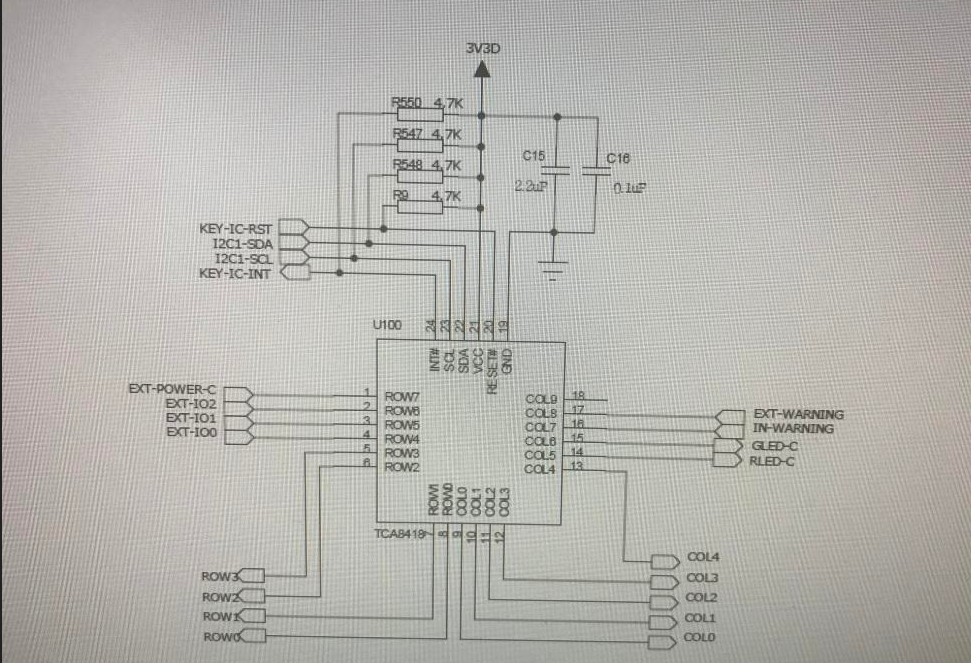Hi team,
The customer is using TCA8418. The schematic and their code is in the attachment. Please check the attachment.
1. Their design is as below:
(1). COL0-COL4 and ROW0-ROW3 combined to a 4*5 KEYPAD;
Best Wishes,
Mickey Zhang
Asia Customer Support Center
Texas Instruments
void iic_delay(void)
{
unsigend char delaytime = 125;
while(delaytime--);
}
void TCA8418_reset(void)
{
GPIO_ResetBits(GPIOC,GPIO_Pin_10); //Pull down reset pin
iic_delay( );
iic_delay( );
iic_delay( );
iic_delay( );
GPIO_SetBits(GPIOC,GPIO_Pin_10); //Pull up reset pin
}
sendbyteto_TCA8418(xxx,xx);//write to the xx data to the xxx register
readbytefrom_TCA8418(xxx);//read the xxx register value
void TCA8418_init(void)
{
TCA8418_reset()��
iic_delay( );
iic_delay( );
iic_delay( );
iic_delay( );
sendbyteto_TCA8418(KP_GPIO1,0x0F); //write 0x0F to the KP_GPIO1 register
iic_delay( );
sendbyteto_TCA8418(KP_GPIO2,0x1F);
iic_delay( );
sendbyteto_TCA8418(GPIO_DIR1,0x80);
iic_delay( );
sendbyteto_TCA8418(GPIO_DIR2,0x60);
iic_delay( );
sendbyteto_TCA8418(GPIO_INT_EN1,0x70);
iic_delay( );
sendbyteto_TCA8418(GPIO_INT_EN2,0x80);
iic_delay( );
sendbyteto_TCA8418(GPIO_INT_EN3,0x01);
iic_delay( );
sendbyteto_TCA8418(GPIO_DAT_OUT1,0x00);
iic_delay( );
sendbyteto_TCA8418(GPIO_DAT_OUT2,0x00);
iic_delay( );
sendbyteto_TCA8418(GPIO_DAT_OUT3,0x00);
iic_delay( );
sendbyteto_TCA8418(CFG,0x53);//CFG = 0x01
iic_delay( );
}
void hand_tca8418_event(void)
{
unsigned char int_stat = 0x00;
unsigned char key_lck_ec = 0x00;
unsigned char key_event_a = 0x00;
unsigned char temp = 0x00;
unsigned char temp_cycle = 0x00;
int_stat = readbytefrom_TCA8418(INT_STAT); //read the INT_STAT register value
if(0x01 == int_stat)
{
key_lck_ec =readbytefrom_TCA8418(KEY_LCK_EC);
temp = key_lck_ec &0x0f;
if(0x01 == temp)
{
key_event_a = readbytefrom_TCA8418(KEY_EVENT_A);
MSG_DRV_SEND(MOD_KEY_ID,key_event_a); //Send the key events and parameters to middleware
}
else
{
if(temp >10)
temp = 10;
for(temp_cycle = 0;temp_cycle <temp;temp_cycle++)
{
readbytefrom_TCA8418(KEY_EVENT_A);
}
}
}
else if(0x02 == int_stat)
{
temp = readbytefrom_TCA8418(GPIO_INT_STAT1);
if(0x10 == temp)
{
temp = readbytefrom_TCA8418(GPIO_INT_LVL1);
if(0x10 == temp)
{
MSG_DRV_SEND(MOD_KEY_ID,0x65);
set_low_extio0_int( );
}
else
{
MSG_DRV_SEND(MOD_KEY_ID,0x65|0x80);
set_high_extio0_int();
}
}
readbytefrom_TCA8418(GPIO_DAT_STAT1);
readbytefrom_TCA8418(GPIO_DAT_STAT1);
readbytefrom_TCA8418(GPIO_DAT_STAT2);
readbytefrom_TCA8418(GPIO_DAT_STAT2);
readbytefrom_TCA8418(GPIO_DAT_STAT3);
readbytefrom_TCA8418(GPIO_DAT_STAT3);
}
else
{
}
sendbyteto_TCA8418(INT_STAT,0x1F);
}
unsigned char ext_status = 0x00;
void set_high_extio0_int(void)
{
ext_status |= 0x10;
sendbyteto_TCA8418(GPIO_INT_LVL1,ext_status);
}
void set_low_extio0_int(void)
{
ext_status &= 0xef;
sendbyteto_TCA8418(GPIO_INT_LVL1,ext_status);
}


